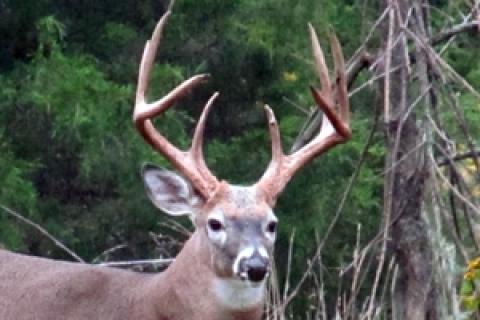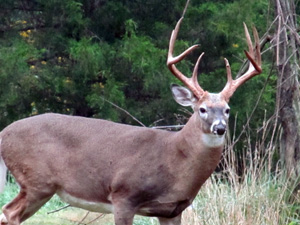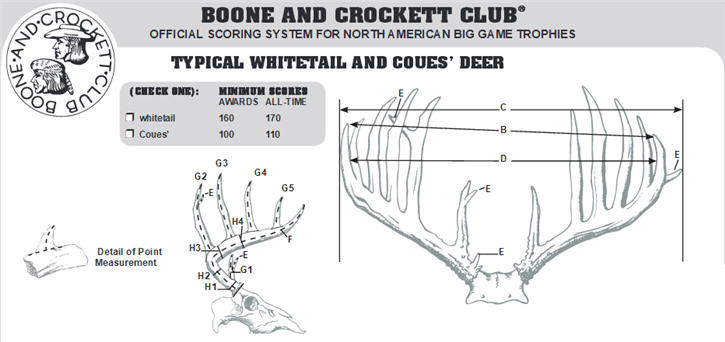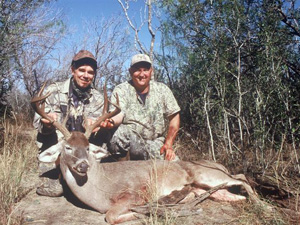
Hunters, while it's a mistake to become obsessed with what a deer's antlers would score, there are many valid reasons to be interested in this measurement of the rack an animal carries. For one thing, a buck's score is a valuable way to describe how large the buck is.
TIP: Shop deer hunting gear here, shop hunting clothing here.
If you say you shot "an eight pointer," it really doesn't tell a person much. That deer could be a precocious yearling that probably should have been passed up, unless you are a young hunter. On the other hand, it could be a five-year old with massive, dark horns and 5-inch bases that weighed over 200 pounds.
Why is Scoring a Deer Important?
 Citing a score pins down the description much more precisely. It's another physical trait that can be used in addition to weight to paint a mental picture of the animal.
Citing a score pins down the description much more precisely. It's another physical trait that can be used in addition to weight to paint a mental picture of the animal.
The score of a deer is also a useful piece of biological information. Genetics, age and nutrition all are involved in how an animal develops. If you manage your local population by trying to pass up young bucks and take enough does, scoring deer you harvest can help you monitor the progress of your program.
The score of a deer is also important for what it symbolizes. When you take a whitetail that scores above average, you have successfully outwitted one of the cagiest of big game animals-a specimen that has likely survived at least three or four hunting seasons.
That brings up a final point. Though score cannot be directly correlated to age (see sidebar below), a deer that scores higher usually represents an older animal. And that is something particularly important to many of us as we become more and more serious about the sport.
There are many scoring systems in use, but the favorite of most hunters is the Boone & Crockett method, with the gross score the one hunters use commonly to describe a buck's antlers. (The net score is mainly of interest if you plan to enter the buck in that organization's record book.)
How to Figure the Score of Deer Antlers
So how do you quickly judge a deer's antlers in the field to estimate a rough score? Three things help with this task-study, practice and experience.
You want to be able to come up with a "guesstimate" that is within 5 or 6 points or inches of the actual score. I've hunted with some biologists and guides who could pin it down to within 2 or 3 inches almost every time, but if you can get it within 5 inches, you're doing well.
Sometimes you may have long minutes to study a buck as it feeds in a field. Other times the animal may just give you seconds. Use your best judgment, and if in doubt, pass it up. It's probably smaller than you first thought. And it's no fun to find that out after you pull the trigger.
Before trying to analyze a bucks' rack, make a rough, ballpark estimate of the score based on your initial overall visual impression. Frame, tine length and mass are the three things my mind instantly focuses on. Counting points, estimating spread, etc. — all that can come later.

Is it a 110? 120? 130? Look at other bucks and illustrations online or in books with scores included to get a rough idea of what such an animal looks like. Then try to "burn" that image into your head so you have a concept of what that type of deer appears like.
Be aware of some potential pitfalls, though. A buck from the back view always looks bigger. Darker antlers also look larger than whiter ones. If you hunt in northern Canada, the large bodies make the antlers look smaller than they actually are.
If you have time after your initial quick "guesstimate," begin analyzing the four measurements that are included in a B&C score.
Boone and Crockett Score Measurements
These include inside spread, main beam, length of tines and mass, which is measured at four locations on each side.
Let's start with mass. To me this is the most appealing and exciting thing about a trophy whitetail. It's almost always associated with older bucks. The more mature the deer, the "heavier" the rack.
Older deer usually have good mass not only at the base, but also carry it out through the main beam. Mass measurements are taken between the antler butt and the brow tine and between each of the next three points, or halfway between the last point and the end of the beam if the buck is an eight pointer.
There aren't many good tricks for judging mass in the field. One is to compare it to the deer's eye. That typically is about 3 1/2 to 3 3/4 inches around.
TIP: Boone & Crockett OFFICIAL SCORING SYSTEM FOR NORTH AMERICAN BIG GAME TROPHIES
If a buck's mass is larger than that it's likely at least three years old. If it's much heavier, it's likely four or five. Field experience and looking at books and magazines are the best way to learn to estimate mass.
Inside spread is one score factor that's a bit easier to pin down. Some hunters are infatuated with spread, but it's not as important in the final tally as some other measurements.

One of the highest-scoring bucks ever killed, a deer shot by Wayne Stewart of Minnesota, for example, only had a 15 5/8-inch inside spread. Yet it made it into the top ten with a net score of 201.
The best way to judge spread is by comparing it with the distance between a whitetail's ear tips in its naturally alert position. This varies from about 15-17 inches, but typically runs about 15 1/2 to 16 inches. If a rack comes outside the ear tips, it's definitely above average and is likely at least two years old, probably three.
Main beam length is a very important component in a deer's score. Top record book whitetails have beams over 2 feet. Brian Damery's amazing 200 2/8 inch buck taken in Illinois in 1993 had 32-inch beams! The Jordan buck had 30-inch beams.
For most locations a main beam over 20 inches signifies at least a three year old animal. Bucks that have antlers jutting straight up or straight forward usually have fairly short beams. The top bucks often have a sweep or curl in the beam that adds extra length.

Beams that extend forward to a line drawn vertically with the nose are usually easily twenty inches or more. If the beams have a lot of curl, they could be quite a bit longer than that.
You can also use a buck's ear as a comparison. A buck's ear is about 6-7 inches tall, so you can extrapolate how many ear lengths the beam seems to be to get a rough idea of its length.
The number and length of points are the final items to consider in rough scoring a deer on the hoof. Try to get a quick count of the number of points on one side, and if time permits, count the other side, too.
Start with the eye guards or brow tines. This is often where bucks are lacking and where truly outstanding animals gain extra inches. A two to four inch brow tine is fairly typical. Five to six inches is excellent.
The second point (called the G-2) is another key area in determining a buck's score. Good bucks will have at least seven or eight inch second points. Outstanding animals may have G-2's 9-11 inches long.
The third point may be shorter or longer than the second, but it too should be eight inches or longer on an outstanding buck. As with main beam, comparing point length to ear length (6-7 inches) is a good way to estimate tine measurements in the field.
The fourth point to size up on each side is only found on 10 pointers or better. This is where many eight pointers lose out on score because even if this last point is only say three inches long, that's six total points they don't get in the final tally. And that is a fairly typical measurement for a good solid ten pointer's last tine — about 2-3 inches.
So there you have the figures. How quick you are with math in the head will help you tabulate an estimated score of a buck on the hoof.
For a hypothetical buck, let's figure four mass measurements averaging 3 1/2 inches doubled for 28 inches. Add 16 inches for inside spread, a total of 44. Add 22 inch main beams twice for 44 inches, a running total of 88. Now tally in doubled point length totals of 3, 8, 7 and 3, for a total of 42, and you have a ten point buck that scores 130.
That may not sound all that impressive. But the fact is a 130 inch buck, is a very good, solid animal for most parts of the country.
Sure, there are 140's, 150's and higher roaming the woods. But a 130 whitetail (in the wild, not on a preserve) is a fine buck. And if you were conservative with your measurements, who knows, he may even wind up being a 135 when you do the final score.
Personally, I would never let score become an overriding consideration in my hunting. But it is one interesting aspect of the whole multidimensional deer hunting experience. Ignore it if you like, but don't criticize or look down on others if they are interested in it.
* Books and videos are available on how to estimate deer scores and age animals through the Quality Deer Management Association. Also visit taxidermy shops and rough score deer on display in your head. Then find out what the animal actually scored and see how close you were.
Aging Deer on the Hoof
To some hunters the age of a deer is even more important than its score. Knowing how to age a deer is every bit as crucial as knowing how to score it, since a high-scoring deer may still be fairly young and have much more potential if it was allowed to grow another year or two.
Learn the physical traits of each age-class, and then you'll know whether you want to pass it up, or if it fits the age for harvesting for the property you're hunting.
Aging 1 1/2 Year Old Buck
These deer are often described as looking like "a doe with antlers." They have a feminine, delicate look with long legs, narrow hindquarters and a thin neck. They might have spikes or as many as eight small points, but these are spindly racks and not easily mistaken for those of a mature deer.
Aging 2 1/2 Year Old Buck
These bucks hind quarters have filled out a little, and their necks swell ever so slightly during the rut. But their legs still look long. Their backs and stomachs are flat with no sagging. Faces have a narrow, pointed look. Outside antler spreads are typically still inside the width of the ears, meaning less than 16 inches.
Aging 3 1/2 Year Old Buck
These bucks are getting heavy chest areas, but the chest is still distinct from the neck and does not "blend together" as it will in older, more mature bucks. The hind quarters have become rounded instead of square like they are on younger bucks.
The chest will appear deeper than the hindquarter area. These deer are thickly muscled, often compared to a well-bred racehorse.
Their noses will be broader and squarer than the thin, pointed snouts of younger bucks. They have achieved 75 percent of their potential antler growth and act aggressively, often challenging older bucks.
Aging 4 1/2 Year Old Buck
These bucks' necks swell fully in the rut and they appear to blend seamlessly into the shoulders. The neck is thicker than the head during breeding season and tarsals become very dark and stained.
The waist is as deep as the chest, but the belly does not sag. The legs start to appear short because the body is so thick. Typically the rack has achieved 80-90 percent of its full potential.
These deer are largely nocturnal in hard-pressured hunting areas and stay mostly in thick cover. They fight for dominance and often have broken racks and up to two dozen wounds after the rut from battles.
Aging 5 1/2 Year Old Buck
This is about the oldest age that can be distinguished on the hoof. From here on up deer will look largely the same unless they decline in extreme old age, meaning 8-10 years or more.
Both the back and belly sag down. There is often loose skin on the face and on the body. The nose is typically short and squat, Roman shaped. Eyes are often "squinty."
The chest blends into the neck in one solid mass. Tarsals become extremely dark during the rut. Racks may begin to sprout kickers and non-typical points.
Often these deer walk stiffly from arthritis and wounds. Some of them may even shy from battle with younger bucks in their prime. Antlers typically peak at either five or six years of age, and may decline after that.
- 115823 views

